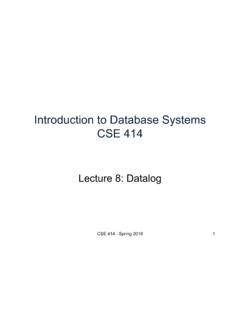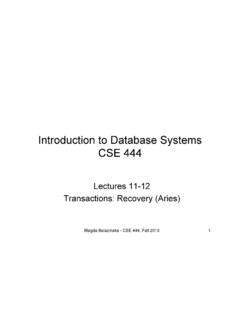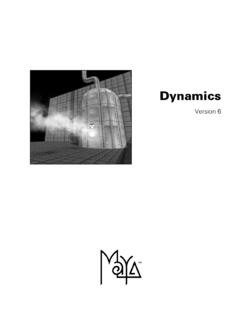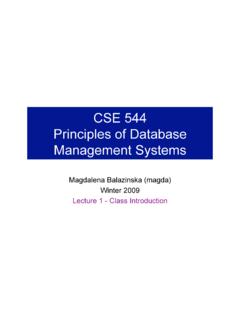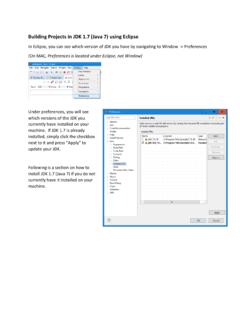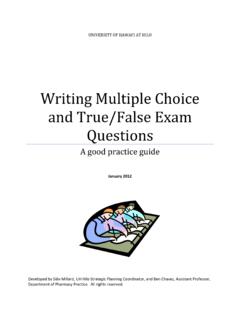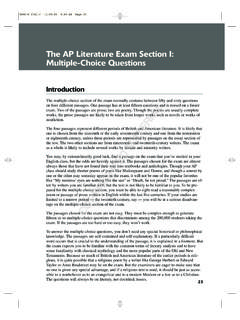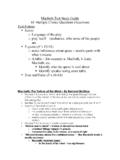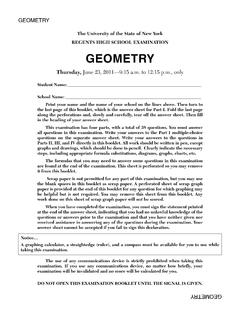Transcription of Part I: 22 Multiple choice questions (2 points each)
1 Part I: 22 Multiple choice questions (2 points each) Answer all of the following questions . READ EACH QUESTION CAREFULLY. Fill the correct bubble on your mark-sense sheet. Each correct question is worth 2 points . Choose the one BEST answer for each question. Assume that all given C++ code is syntactically correct unless a possibility to the contrary is suggested in the question. Remember not to devote too much time to any single question, and good luck! Suppose we need to sort a list of employee records in ascending order, using the social security number (a 9-digit number) as the key ( , sort the records by social security number).
2 If we need to guarantee that the running time will be no worse than n log n, which sorting methods could we use? A. mergesort B. quicksort C. insertion sort D. Either mergesort or quicksort 1. E. None of these sorting algorithms guarantee a worst-case performance of n log n or better Consider the following function f: int f(int n) { int s = 0; while(n > 1) { n = n/2; s++; } return s; } What is the asymptotic complexity of f in terms of n?
3 (Pick the smallest correct answer) A. )log(nnO B. )(nO C. )(nO D. )(lognO 2. E. )(2nO CSE 143 2000WI Final Exam Version B Page 2 of 16 The most important reason for including a destructor in a class is: A. To print a message for debugging purposes B. To store information about an object before it goes out of scope C. To free up resources allocated by that class D. To reset the original object s pointer to NULL 3. E. To make your TA happy One of these code fragments calls the copy constructor for class A. Which one? (Assume that doSomething is a void function with a parameter of the appropriate type.)
4 A. A a; B b; a = b; B. A array[20]; C. A a; doSomething(a); D. A* a; doSomething(a) 4. E. A a; doSomething( Consider a class List that implements an unordered list. Suppose it has as its representation a singly linked list with a head and tail pointer ( , pointers to the first and last nodes in the list). Given that representation, which of the following operations could be implemented in O(1) time? I. Insert item at the front of the list II. Insert item at the rear of the list III. Delete front item from list IV. Delete rear item from list A.)
5 I and II B. I and III C. I, II, and III D. I, II, and IV 5. E. all of them CSE 143 2000WI Final Exam Version B Page 3 of 16 What output does this C++ program produce? #include <iostream> using namespace std; class Bird { public: virtual void noise( ); }; void Bird::noise( ) { cout << "chirp "; } //-------------------------------------- --- class Duck: public Bird { public: virtual void noise( ); }; void Duck::noise( ) { cout << "quack "; } //-------------------------------------- --- class Goose: public Bird { public: virtual void noise( ); }; void Goose::noise( ) { cout << "honk "; } //-------------------------------------- --- int main() { Bird tweety.}
6 Goose ralph; Duck donald; tweety = donald; ( ); ( ); ( ); return 0; } A. chirp quack honk B. quack quack honk C. chirp chirp honk D. chirp chirp chirp 6. E. The program won t compile because the variable types in the assignment statement aren t compatible CSE 143 2000WI Final Exam Version B Page 4 of 16 Consider a class List that implements an unordered list. Suppose it has as its representation a dynamically expanding (resizeable) array. Which of these operations might need to delete some dynamically allocated storage to avoid a memory leak?
7 I. Default Constructor II. Copy Constructor III. Destructor IV. Assignment operator A. I and II B. II and III C. II and IV D. III and IV 7. E. II, III, and IV What is the postfix representation of this expression? (12 a) * (b + 9) / (d * 4) A. 4 b * d 9 + a 12 - * / B. / 12 a b 9 + d 4 * C. 12 a * b + 9 / d * 4 D. 12 a b 9 + * d 4 * / 8. E. None of the above What is the asymptotic runtime for traversing all nodes in a binary search tree with n nodes and printing them in order?
8 A. ))log((nnO B. )(nO C. )(nO D. ))(log(nO 9. E. )(2nO CSE 143 2000WI Final Exam Version B Page 5 of 16 Here is a binary tree. 1 / \ 2 6 / \ / \ 4 9 3 7 / \ 8 5 If we visit the nodes of this tree using a preorder traversal, in what order will the nodes be visited? A. 1 2 3 4 5 6 7 8 9 B. 1 2 4 9 6 3 8 5 7 C. 4 9 2 8 5 3 7 6 1 D. 4 2 9 1 8 3 5 6 7 1 2 6 4 9 3 7 8 5 On your answer sheet, which test version is marked in the box to the right of your student number?
9 (You may mark the correct version before you answer this question if you haven t done so already.) A. A B. B C. C D. D E Assuming that the hash function for a table works well, and the size of the hash table is reasonably large compared to the number of items in the table, the expected (average) time needed to find an item in a hash table containing n items is A. )1(O B. )(lognO C. )log(nnO D. )(nO )(nO If an internet router is receiving packets faster than it can forward them to the next location on the network, the router will A.
10 Return the packets to the sender, and the sender will retransmit them later B. Store the packets locally and forward them when the next router indicates it is ready to accept more traffic C. Discard the packets, , drop them on the floor D. The router will reboot itself, because this is never supposed to happen None of the above CSE 143 2000WI Final Exam Version B Page 6 of 16 Here is a simple class and a short program that uses it. To save space, the method implementations are included in the class declaration, instead of being written separately (this is legal C++, even if not always the best style).


